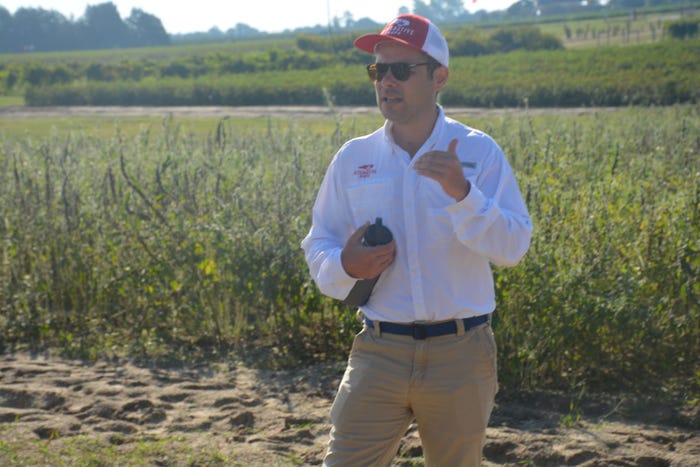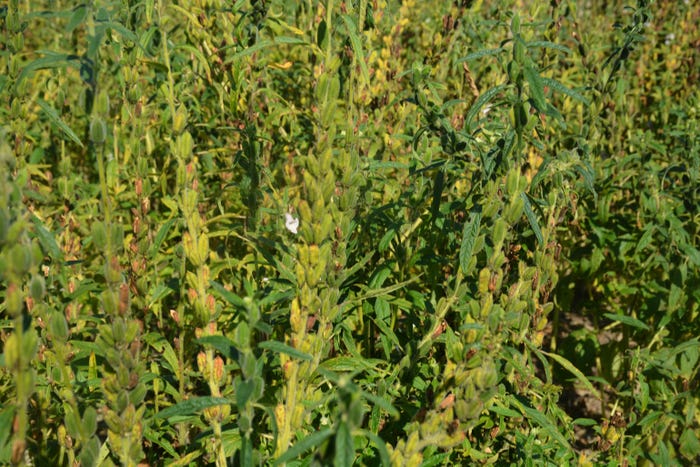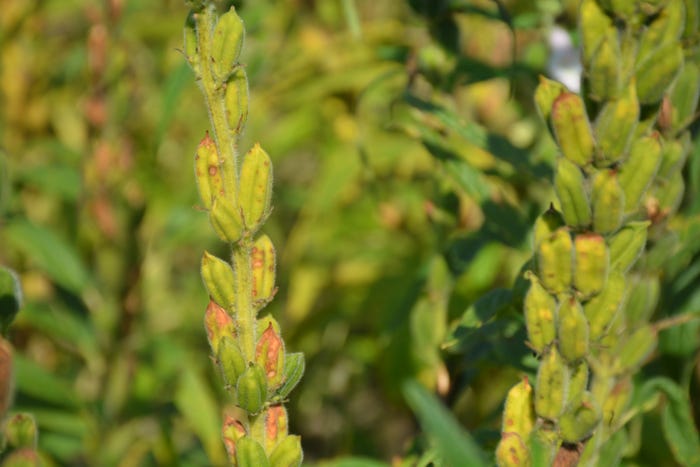
Of all the alternative crops David Suchoff works with as the alternative crops Extension specialist at North Carolina State University, he tends to be most optimistic about the potential of sesame. He believes the tiny seed can work for North Carolina farmers, particularly in the Sandhills where growing crops has always been a challenge.
To gauge the potential of sesame in the Tar Heel State, Suchoff and his team have been conducting research for the past two years at four sites across North Carolina: At the Piedmont Research Station in Salisbury; the Sandhills Research Station in Jackson Springs; the Horticultural Crops Research Station in Clinton; and the Tidewater Research Station in Plymouth. So far, there have been both challenges and opportunities.
Graduate student researcher Marcela Chavez has been working with Suchoff and Angela Post, North Carolina State Extension small grains specialist, conducting a nitrogen rate trial, a variety trial and a plant spacing trial at the four research station sites for the past two years. Suchoff says on-farm research is vital and will begin next year.
“We need to get sesame in the hands of farmers to see some of the bigger challenges they may be facing. We certainly have faced our own. But demand is strong for sesame, and it has been strong for a while. Of all the alternative crops that my program works with, this is the one where we see the most feasibility in the short-term because the demand is there. There is a market for sesame,” Suchoff said at one of three sesame field days at the Sandhills Research Station Sept. 22.
Other sesame field days were held Sept. 20 at the Piedmont Research Station in Salisbury and at the Horticultural Crops Research Station in Clinton on Sept. 21. Suchoff said it’s all part of the effort to educate farmers on the possibility of growing sesame.

North Carolina State University Extension Alternate Crops Specialist David Suchoff believes sesame has the greatest potential of all the alternate crops he works on in North Carolina. (John Hart)
Seeking farmers
With that in mind, North Carolina State University is seeking farmers who would like to give sesame a try and be involved with on-farm research next year. Suchoff invited interested farmers to contact him at [email protected] or phone (919) 515-4792.
He said farmers involved will also be compensated for their time and effort and will be able to sell the sesame they produce next year. He says farmers can grow anywhere from five to 50 acres of sesame. Deadline for enrolling is Nov. 1, 2022.
“This will give us a better idea if sesame is commercially viable in North Carolina,” Suchoff said.
North Carolina State University is working with Equinom, a breeding company, and Sesaco, a genetic developer, processor and marketer of U.S. grown sesame. Sesaco is interested in purchasing sesame from North Carolina farmers next year. Suchoff says Sesaco would like at least 50 acres of sesame planted by North Carolina farmers in 2023.

North Carolina State University graduate student researcher Marcela Chavez has conducted a nitrogen rate trial, a variety trial and a plant spacing trial at four research stations in North Carolina for the past two years. (John Hart)
So, what can you expect when growing sesame?
Essentially, sesame is a low-input, drought and heat tolerant crop that is grown mainly for its high oleic and linoleic acid seed with applications in health food, nutraceutical, and pharmaceutical applications. Uses for whole seeds include paste for hummus and tahini as well as bakery products like rolls and bagels and the famous sesame seed hamburger bun.
Right now, it is grown primarily in Oklahoma and Texas, although it has been grown in the Southeast in Georgia for the past few years. Sesaco currently has contracts with farmers in Georgia to grow sesame and wants to expand across the Southeast.
Suchoff emphasized that sesame is a very low input crop in terms of labor and fertility and the market for sesame remains strong and is expected to remain strong.
“The hardest part of this crop is proper planting. It goes against our traditional planting protocols. Sesame seed is quite small, but has to be planted deep. Instead of thinking about the actual depth we’re going to plant the crop, we need to think about planting into moisture. This is more important than planting sesame at three-quarters of an inch or an inch deep. Seed has to be in moisture, and it has to be in moisture for three days. If it’s in moisture at time of planting and then it dries up because it is too shallow, you lost that seed, and the stand is not going to be that good,” Suchoff said at the Sandhills field day.
Not competetive with weeds
Suchoff emphasized that once sesame emerges, it is a small plant and not that competitive with weeds. He says this is a challenge that must be managed.
“There are both pre-emergent and post-emergent chemistries available, although they are limited. Hopefully, there will be more chemistries down the line that can be used by farmers. Sesame is by no means a competitive crop when it comes to weeds. This is especially true early on in the season. Starting clean is your best bet. Using some chemistries if you can, doing some cultivation if you can as well to help keep the field as clean as possible,” Suchoff said.
A plus of sesame is it doesn’t need a great deal of nitrogen fertilizer. Suchoff says the general fertility recommendations in Texas and Oklahoma is about 75 pounds of nitrogen per acre. He noted that it is important to remember that Texas and Oklahoma don’t receive as much rain as North Carolina. He believes about 80 pounds of nitrogen per acre is the right amount for North Carolina.

Sesame is a low-input, drought and heat tolerant crop that is grown mainly for its high oleic and linoleic acid seed. (John Hart)
“It is not a nitrogen hungry crop. It also does not seem to really require a lot in terms of potassium or phosphorus or really anything above what we already have in our soils,” he added.
As for plant spacing, Suchoff noted sesame plants are very “plastic” and will branch out if given more space. He pointed out that those branches will have more capsules than plants that are crammed together. Because of the plasticity of the plants, Suchoff says there is no benefit of increasing your plants per acre or using a narrower row spacing.
Chavez pointed out that in her research at all four sites, she used row spacings of 7.5 inches, 15 inches and 30 inches, all with the same seeding rate. Small Grains Specialist Post, further pointed out that the plasticity of sesame allows for those multiple row spacings.
“As far as harvestability goes, and keeping that crop standing all the way to the end of the season, that wider row spacing is going to be a little better, not only for weed control, but you will get more branching and the plants can hold themselves up,” Post said at the field day.
When it comes to planting, Suchoff advised against using a drill. He says using a planter is the way to go because it offers better depth control.
Disease challenges
Suchoff does make it clear that diseases, particularly leaf spot, in sesame will be more of a challenge in North Carolina than in Oklahoma and Texas with their drier climates. “When the crop is starting to flower, you want to get some type of fungicide application just in case.”
Still, there are many benefits to sesame. Top among them is that sesame is nematode resistant, which will make it a good rotation crop in North Carolina. Suchoff considers sesame’s nematode resistance to be one of its greatest strengths. Other strengths: It is a very pollinator friendly crop at flowering and deer don’t like it.
Sesame should be planted in North Carolina from mid-May to the end of June and should be harvested in late September to October. Post noted that at harvest, desiccants are needed because North Carolina does not usually get an early freeze.
“When it comes to combine settings, you won’t need to purchase new equipment. You can retrofit what you have. Sesame is similar to other small oilseeds in that the seed kind of flows like water. If you have small holes in the equipment you are working with, you’re going to want to tidy those up before you get started so you make it down the road or out of the field with all of the seeds you are harvesting,” Post said.
Because of strong demand and good prices for sesame, both Post and Suchoff believe many North Carolina growers will give the crop a try.
Suchoff estimates production costs for sesame at $175 to $200 per acre. The market price for sesame at the time of the field days was 60 cents per pound. He noted that in their small plot research, yields were anywhere from 600 to 2,000 pounds per acre, equating to a market value of $360 on the low end of 600 pounds per acre and $1,200 per acre at the high end of 2,000 pounds per acre.
Suchoff believes most North Carolina farmers will be able to hit the 1,000-1,500 pounds per acre yield mark. “If you’re getting 1,000 pounds per acre, you’re doing really well,” he said.

North Carolina State University and the New and Emerging Crops Research Program in the North Carolina Department of Agriculture is seeking farmers who would like to give sesame a try and be involved with on-farm research next year. (John Hart)
About the Author(s)
You May Also Like






